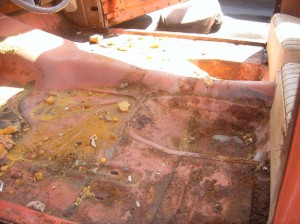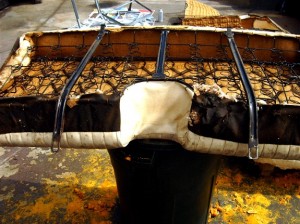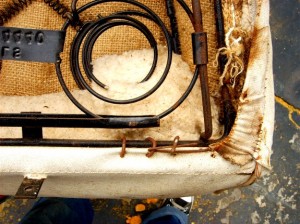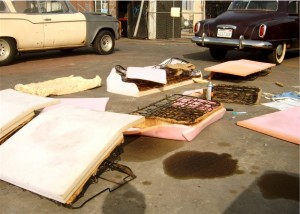Car Interior 102 – Rebuilding Your Seats
Looking at this picture now, I can no longer imagine my original plans were to simply slap some seat covers on and call it a day. I changed my mind when I realized these ol’ seats had been rat-infested and that the majority of my time spent with my car would be sitting in the driver’s seat! Making over my car’s interior was one of the first jobs I tackled alone on my 1955 Studebaker. Whenever I open the door and sit on my plush and sturdy bench seat, I’m thankful that I took the time.
This article is just one of an entire series focusing on how-to rebuild your car’s interior yourself, next up will be Car Interior 103 – Auto Upholstery. Before we get to upholstering, let’s make sure you’ve got a good foundation to put that pretty new fabric on. Following the steps below will get ya ready to ride in style and comfort!
1.) Pull the seats out of your car.
You can’t very well work on those seats while they’re still inside the car! This job is easiest when you’ve got plenty of room to work. Having a friend to help with the lifting is a big bonus too!
Most every seat is going to made a differently, so spend some time observing how yours are put together. In my car, I have to slide out the bottom seat parts before being able to unbolt the frames of the upper seat parts.
 2.) If the car floor needs any work, now’s the time to do it.
2.) If the car floor needs any work, now’s the time to do it.
If you have any floorboard holes or weaknesses, this is the step where you’d want to get them taken care of. You’ll also want to clean it and I would really suggest adding a noise-dampener layer as well.
First I vacuumed and mopped up debris then followed with a good degreaser such as Purple Power. To stop a small amount of rust that had began, I used a rust-stop chemical. Then I was ready to apply the noise-dampener. There are many different noise/temperature protectors to choose from ranging from brush on (like I used) to cut & tape. These vary in price and quality, so now what your needs are and look around.
 3.) Strip the seats down to the frame.
3.) Strip the seats down to the frame.
It’s demolition time. I found it helpful to take pictures along the way – so when I got curious about how something was originally put together later on during this process, I had hard proof of it!
First I tore apart the original upholstery and unlayered the levels of padding. If your upholstery is in good enough shape to use as patterns for next time, be very careful in handling it. Keep all upholstery in solid pieces, using small scissors or a seam ripper to separate each piece. When all this is finished you should have a bare metal frame with springs and other foundational elements attached (many cars may have some sort of burlap/jute underlayer also.)
 4.) Do necessary mending to seat frame.
4.) Do necessary mending to seat frame.
I didn’t have any problems with my seat frame in its original condition, so you’ll have to be the judge on your project. However, if springs appear to be out of place or there is excessive rust, you’ll need to do some work on that before refoaming. Sometimes springs can just be re-wired back into the correct position. Other times you may need to replace a spring – or perhaps the entire seat.
If you’re putting a different seat into your ride, be sure to take very good measurements. It needs to fit inside (with doors closed) and put you at the correct ride-height when driving.
5.) Get your foam ready.
As much as I can tell, everybody uses foam material to build seats with nowadays. The stuff that was on my seats originally was a small layer of foam with a larger layer of cottony stuff on top…but to replace it I used only foam. This can be purchased at a car upholstery supply shop. I was able to find one within 20-miles of my house by checking internet listings.
Bring a picture of your project along with you, so the people working in the shop can best advise you on what materials you’ll need. Or, like my friend Luis said, discuss your project with a professional car-interior person and they’ll probably have tips, suggestions, and resources for you. (For example, MyRideisMe member MikeyBigBlock has offered to answer upholstery questions!)
The supply shop I went to advised I use 2-layers of thick foam (although 1 probably would’ve worked better) covered with 1-layer of thinner, less dense foam.
 6.) Rebuild your seats with the new foam.
6.) Rebuild your seats with the new foam.
Paying attention to where padding was at on your seats when you took them apart, reapply the new foam. On my seat-bottoms I used 2 layers of thick foam – using upholstery glue to hold them together (although don’t depend on the glue to hold.) The upper-seats only got one layer of thinner foam. This foam needed to be wrapped around the top and sides on my seats. I made this work by cutting a triangle shape out of the foam at the top corners. Remember that ultimately it’s the upholstery that is going to keep everything in its proper place.
When all the foam was on, I used a razor blade to round off the front bench seats edges. Take great care in ensuring that the foam is smooth in all areas. If there’s a bump or ledge anywhere, it’s not going to disappear when you put upholstery over it!
7.) If you haven’t already done it, choose your fabrics and get ready to upholster!
There is a lot of variety in car interiors. If you need any help planning out what color scheme or look to give your car interior – take a look around at various cars interior’s during your next car show. They range from single, solid color to fancy patterns and more.
I’ll be talking more about choosing your fabrics and upholstering your seats in my next article, Car Interior 103 – Auto Upholstery. If you have any questions or suggestions, leave a comment below…until then, good luck and happy trails!








Cool! Nice work Greaser! The before pic is pretty bad. Glad you redid those babies.
I need some springs for my front seat in my 1959 Lark. Bench seat. To Door. Three are broken. Can you help Thanks Tom Meridian Idaho Ph 208-412-5679
Tom-
I don’t have any extra springs – the Studebaker Drivers Club forum is a great place to start for any Studebaker-specific inquires though…check it out!
http://forum.studebakerdriversclub.com/
Hello, I am rebuilding some bucket seats for a 1978 Trans am, was wondering, what is a good tear proof material to cover the springs with between the springs and foam?
Thank you,
Thorne- I don’t know if the springs on your 78 seat look the same as the one’s in mine shown above. As you can see in the pictures – there was a heavy burlap material between the springs and foam originally. I believe in my case I decided to continue using the original burlap as it was in surprisingly good condition still!
Good luck with your seats! Also, I just found a great web resource for upholstery…it’s a website called thehogring.com.